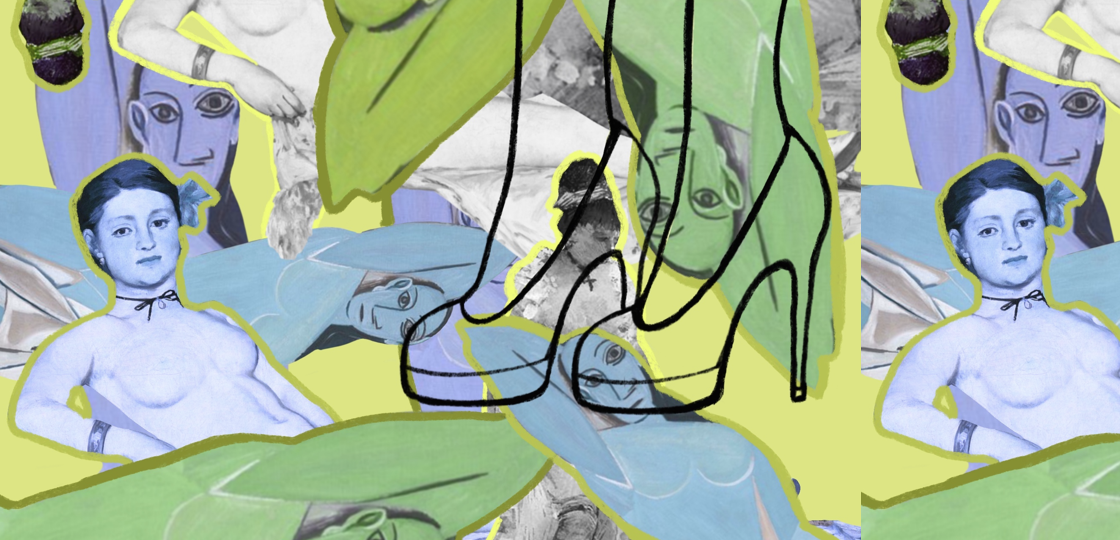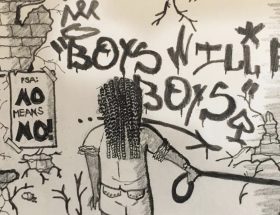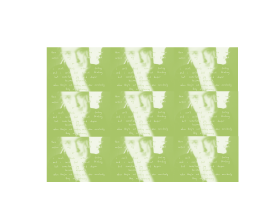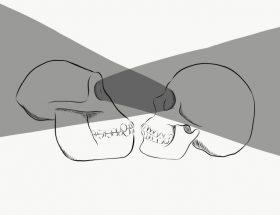[Content warning: mention of eating disorders and body image issues.]
“I don’t understand how women have body image issues. I just don’t get it.”
It is rare for my words to dissolve into my stomach, rare for my brain to choke on my own thoughts, and yet, that day, the day a boy I liked– make no mistake, few 21-year-olds are actually men– said this to me, my only reply was
“What?”
I watched the conversation fizz away into our beers, watched myself sit there almost motionless while he questioned how hard it could be to look at your own reflection in the mirror and think yeah, I look great, while he laughed off the weight of the topic from his chest and ordered another drink. My consciousness watched his short monologue unfold and crash against the empty shell that was suddenly my body, splashing it with a form of shame so sticky that I still haven’t quite managed to peel some of his comments off my skin.
That night is one of the many scenes that I constantly play over and over in the back of my head because, for the first time in my life, someone I thought I knew, someone I believed to be informed about the broken society we live in, cornered me with his ignorance, and I–
I said nothing.
I said nothing despite knowing exactly what I wanted to say because I was too scared of exposing myself. I didn’t want my words to reveal how the experience he was actively disregarding had been visceral to me; how intimate I had been with a feeling he condescended. As if that were a bad thing. Something to hide.
The invisible is that which cannot be seen or perceived, a state of being which we tend to attribute to the nature of the thing in itself, dismissing the possibility of us (people) playing any part in the invisibility. Oxygen, invisible. Carbon dioxide, invisible. Both gain visibility when they absorb light at infrared and ultraviolet wavelengths; it is not intrinsic to their nature to be invisible. But the human eye cannot perceive these wavelengths– so they remain invisible in the public psyche.
The invisible says more about human abilities than about the thing in itself. It conceptualizes human perspective, describing the limits of our agency over our overall perception. The invisible is misleading. It makes us believe that everything we, at whatever point, have discerned as such escapes our control; it allows us to be selectively powerless.
That boy’s unnecessary take on body image issues was a decision, a decision to refuse to engage with the information at his disposal– be the experiences of the women in his life, or his own ability to extract interpretations from the society in which he lives in–, a decision to reduce what he knew to be a common issue to senseless concern. A decision to render it invisible.
Ongoing media discussions– if we can call them that– of body image issues and eating disorders have encouraged us to believe that we are finally addressing one of the pivotal problems to our societal obsession with beauty. The critique of the ideal of the perfect body has been repeatedly posited; the continuous scrutiny of female physiques and, by extension, the definition of certain characteristics as inherently flawed, has been presumably rejected. There has been a shift in the recognition of the problem, from denial to confrontation. It hasn’t been solved, but we seem to be trying– or we, at least, believe we are. The comment that boy made thus appears to be lightyears away from the current media-slash-public stance on the matter.
I think this is false. As much as I would like to fully blame him for his ignorance– and believe me when I say, I truly do in many ways–, I also realized that night that his attitude was a simplistic parallel to the societal practice of neglecting women’s experiences, despite knowing they are there.
I believe the connection lies in the choice of invisibility when it comes to the location and meaning of beauty.
The immediate societal solution to the ideal-type-problem affecting female bodies has been the hail of inclusivity and diversity. Shows like Rihanna’s Savage X Fenty have made a point out of rejecting the slim-tall-white body type as the only one that can be defined as beautiful, by incorporating women from other races, and women whose bodies, in their size and shape, push the limits of the current cannon. General applause. It is undeniable that inclusivity and diversity are major and necessary steps forward; still, I don’t think they are the all-in-all solution to the pervasive body image crisis. There is a common thread between all public media portrayals of beauty, be they inclusive and diverse or not, that contributes to the obsession with the perfect body. It rests on the connection between beauty and desirability. On the link between beauty and the sensual.
Think about it. I’m not talking about being cute or pretty; while we may at times use them interchangeably, I’d argue that we can make a nuanced distinction between those attributes and the state of being beautiful. Cute and pretty are not necessarily sexually charged terms– they are almost sugar-coated. They do positively refer to the physique of a woman, yet they tend to do so, especially cute, in a way that could hardly be described as lustful. Beautiful, however, implies a recognition of a degree of attraction because, like it or not, we are, generally speaking, inherently sexual beings.
A woman is beautiful when she is explicitly fuckable.
A woman can only be explicitly fuckable via her body. This can directly take the form of physical attributes– her breasts, her thighs, her butt, her skin–, or indirectly present itself through additions (material or not) to her physique– the pose of her body, legs slightly open, an arched back, or pouting of the lips; strong makeup or clothing that reveals the tenderness underneath. In public media depictions of female beauty, this fuckability has become a double-edged sword. In its abrupt break away from centuries of repression of female sexuality, it allows us to claim what is intrinsically ours– our ability to be sensual– and to exhibit it as a positive attribute, now naked from the shame and guilt that once clothed it. It becomes empowering. The problem is, however, that when the media presents this beauty-fuckability standard, it essentially does so in the form of a performance: it transforms it into a way of inhabiting, of owning even, beauty that relies on explicitly trying to captivate the imaginary male voyeur.
This performance is two-fold: it is linked to our basic (and stereotypical) notion of sexuality and to an interpretation of what it means to be seen.
Our societal understanding of what is sensual is deeply rooted in a heteronormative definition of sexuality. It is those features that connect back to the imaginary vision of heterosexual sex– the hips to grab, the lips that suck, the positions the female body finds itself in– that underpin fuckability. Yes, one could argue that these same elements are present in homosexual sex– bodies are bodies, after all– but we cannot overlook the fact that in a society that has been hierarchically constructed around binaries– heterosexual and homosexual, male and female– women continue to be interpreted in relation to men, heterosexuality continues to be prioritized over homosexuality and other sexual orientations, especially in the media. Othering persists and thus, despite the obvious inaccuracy, female sexuality is still predominantly taken at face value to exist and play a role primarily within a heterosexual interaction. Heteronormative fuckability thus pressures compliance even out of those women whose sexual orientation and compass of pleasure are in no way associated to the male ego, overlooking questions of sexual orientation and, by extension, eliminating the myriad of nuances that shape female control over the presentation of sexual identity.
When the beauty of a woman is presented, it is never done so in a vacuum, and this is where the idea of being seen steps in. In a way reminiscent to that described by John Berger in Ways of Seeing throughout his discussion of the male gaze, the beauty-fuckability standard is a reciprocal process: not only is she being observed, but she– just like Manet’s Olympia– is aware that she is. It rejects the naivety of the madonna and her pure oblivion, and elevates the whore in her tenacity to trigger the response of desire that she’s (supposedly) seeking out. It is the knowledge that she is being seen that shapes her behavior, her demeanor. Being beautiful, attractive, desirable becomes a volitional act, one that depends on providing what the male voyeur is looking for. It is the awareness that she is an object of examination under male eyes that gives value to the beauty.
The conjunction of the two elements– our notion of sexuality and to be aware of one’s visibility– reduces the beauty-fuckability standard to one whose worth is directed to an abstract notion of male pleasure, and whose central pre-requisite is fitting into a mold that no woman can cut herself into at every minute of every day.
It is just as unattainable as the white-slim-tall model we’re trying to abandon.
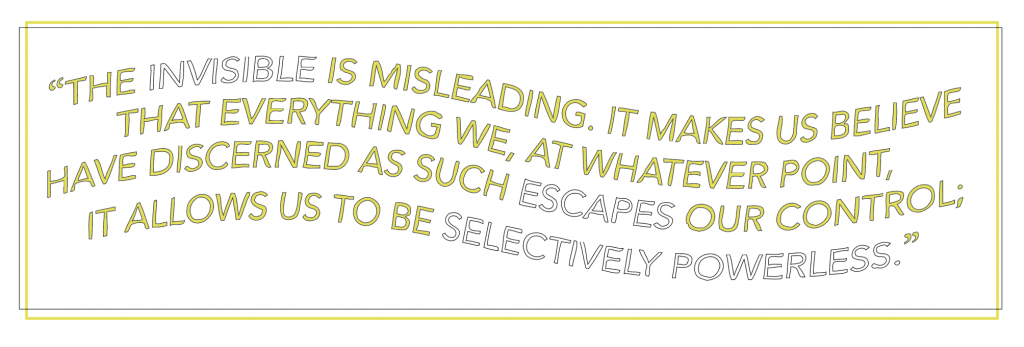
No woman can be sexually intriguing to all men at all times because sexual tension and lust do not work in that way. I could put on a slim fit dress, wear red lipstick, and sensually suck on a banana by the sidewalk all day long and I still wouldn’t be universally sexually desirable. No one is. Sexual attraction is not a simple equation of objective, universal elements. It is the result of individual lived experiences in multiple realms, from encounters with the abstract notion of the aesthetic to the notion of affection and subjective judgments of an infinity of values. The presumption that women can and should strive to achieve unequivocal male yearning is a dangerous vicious cycle. It prevents women from being the judges of their own aesthetic worth, presenting us instead with an ambiguous checklist that can never be fulfilled.
[And there’s the other obvious problem– there’s no winning if you’re gonna be a sexual woman.
If you show too much skin you’re a slut, if you approach too many men– I wonder where the threshold is at– you’re a slut, if you enjoy sex too much– idem– you’re a whore, but if you don’t you’re a prude or a bitch or you just don’t know how to have fun at all. You know how the paradox goes.]
Since the checklist cannot be fulfilled, the beauty-fuckability standard reproduces similar body-image problems to those criticized in the white-tall-slim model of beauty. As empowering as it may be to be fuckable to some, if one is not fuckable to all, the logic goes, one is not good enough. Not good enough legs, not a good enough face, not a good enough butt, not a good enough waist. That is the problem with socially ascribing a notion of objectivity to beauty in a physical sense, no matter what shape or form it takes: it becomes nothing but a new-er scale of worth.
This is what I believe our societal practices, our current media portrayals, have chosen to render invisible– that the packaging may have changed, but the product is the same. That we are still not allowed to be good enough, that we never will, because the scale can be stretched, repainted, and rephrased enough times to make sure that we won’t be.
This societal decision of invisibility is self-serving in the same way that that boy’s comment was. His was almost a form of negging by which his initially making me feel smaller, weaker, irrational allowed his later compliments to gain force, value, and meaning. Society’s is a form of manipulation I lack a term for; the reformatting of an ideal so that line of production never has to stop.
The invisible says more about human abilities than about the thing in itself…
Society and the media serving it are, in many ways, a collection of consumers. Consumers provide demand. Consumers ultimately have the option of accepting or rejecting any ideal that is sold to them. The boy who made the comment is a consumer. I am a consumer.
…it allows us to be selectively powerless.
When I was 13, my stomach felt too rounded, my legs too muscular, my arms too flabby. I wanted to be tall, I wanted to be slim, I wanted to be pretty. Now that I am almost 21 my stomach feels too concave, my legs too thin, my butt too flat. I want to be fuckable, I want to be desirable, I want to be beautiful. I wonder what the mirror will ask me to be when I’m almost 33.
Maybe I’ll just shatter it.
Art by Jennifer van der Merwe

